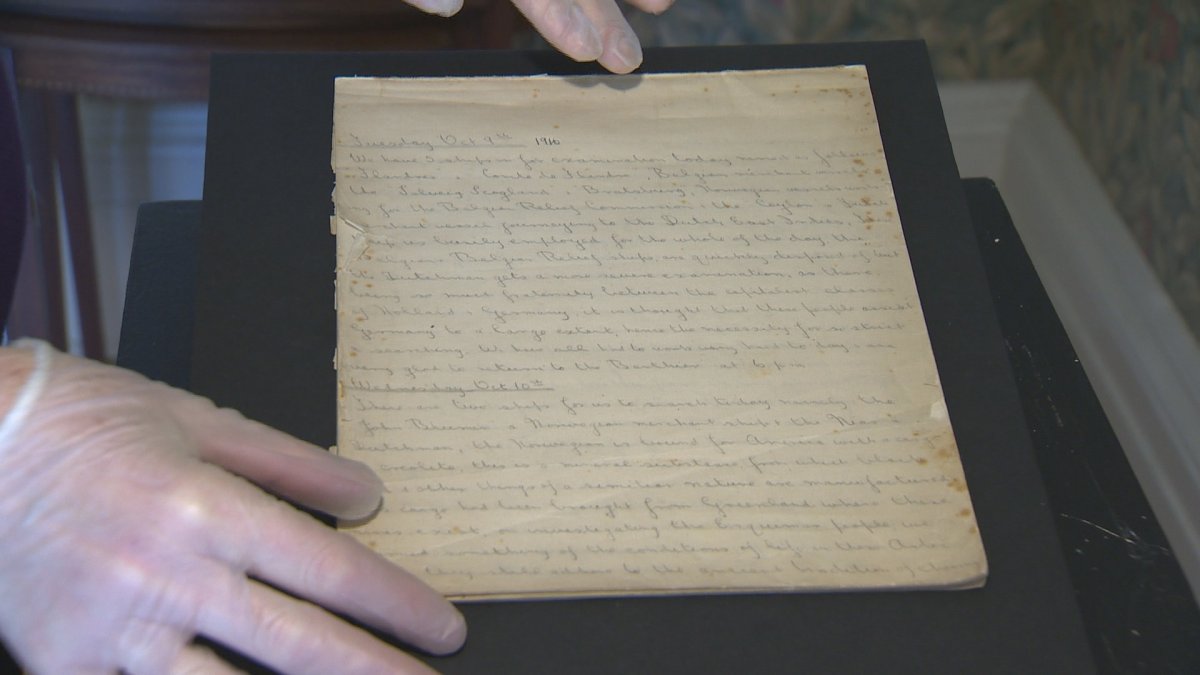Words scribbled in pencil on paper are giving a rare glimpse at life around Halifax harbour in 1916, and most importantly, the time of the Halifax Explosion.

The Dartmouth Heritage Museum unveiled a war diary Wednesday that’s been brought to the province from across the globe.
It all started with an email in January 2016, when Rex Baker decided it was time to reach out to Bonnie Elliott, the Executive Director of the Dartmouth Heritage Museum.
Baker said in the email that his father, Frank Baker, had served in the Royal British Navy during the First World War. He was stationed in Halifax in October 1916 as a patrolman who searched ships arriving in the harbour for hidden cargo and spies.
He said his father also lived in the city at the time of the Halifax Explosion, which took place on December 6, 1917 when two ships collided in the harbour, causing a massive explosion that devastated the surrounding land.
Baker knew little of his father’s time in Halifax, but what he did have was a diary, and in it Frank had written a detailed account of his experiences in the city between October 1916 and January 1917.
- Budget 2024 failed to spark ‘political reboot’ for Liberals, polling suggests
- Train goes up in flames while rolling through London, Ont. Here’s what we know
- Peel police chief met Sri Lankan officer a court says ‘participated’ in torture
- Wrong remains sent to ‘exhausted’ Canadian family after death on Cuba vacation
Diary sat in a drawer in Australia for years
He said he kept the diary in a drawer in his home in Busselton, Western Australia for the past few years, but his wife, Jan Baker, had recently transcribed the 29 pages of the diary.
Baker continued his correspondence with Elliott, which led to the donation of the work to the museum on Wednesday.
He also says he hopes to see his father’s work passed down through the generations.
Although the diary is nearly 100 years old, Elliott says what is most striking about it is the quality of the writing. She praises the careful and precise penmanship that graces the “A7” sized paper and the eloquent style of the writing.
“The transcribed diary was sent to the museum . . . and within 29 pages a rare glimpse of Halifax harbour during wartime emerges,” she said.
The diary features an in-depth record of every ship Baker searched, including information concerning the size, weight, speed, cargo, destination and purpose of each ship.
It also features a descriptive account of Baker’s anxious quest to find loved ones as he journeyed through the wreckage and ruin left in the wake of the Halifax Explosion.
READ MORE: Halifax Explosion survivor Mary Murphy dies at 98
“I think he just writes so well . . . he makes it really real for you. He walks you through it . . . It’s not just a newspaper report. He makes it personal for you,” Baker said.
Baker looks forward to a day where he might see his father’s work published.
“I think it would be wonderful. I’m overwhelmed just by the thought of it. I think it would be fantastic,” he said.
A special exhibit will be created around the diary and unveiled in 2017 to commemorate the 100th anniversary of the Halifax Explosion.



Comments